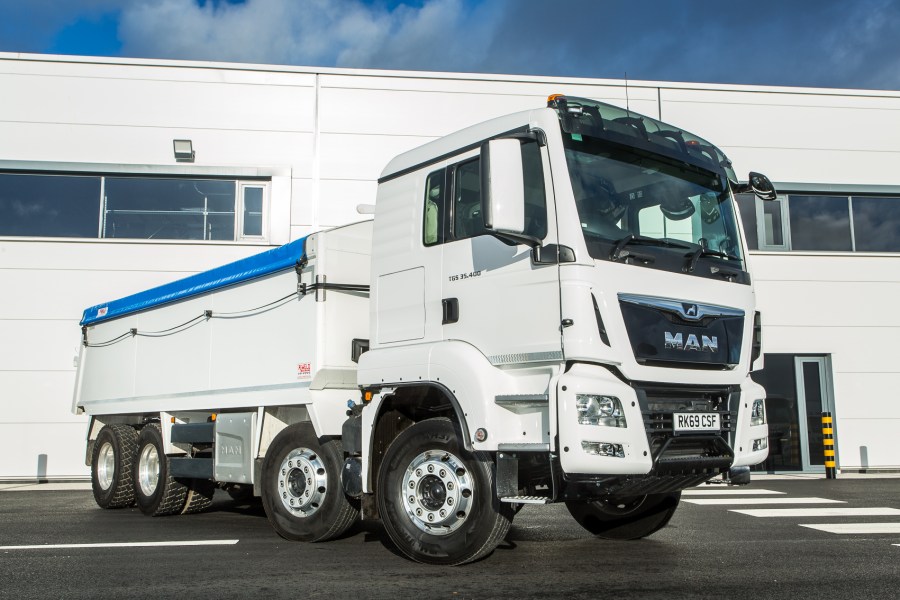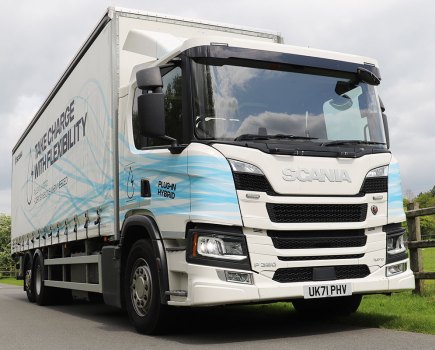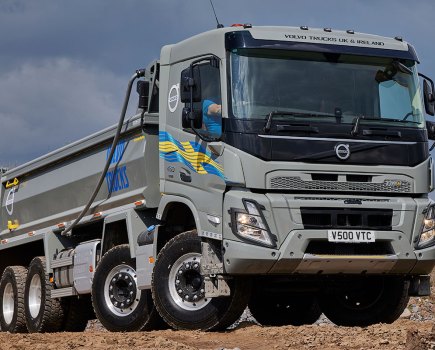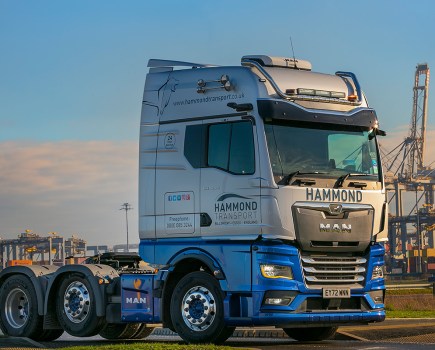With the new D15 9-litre engine, the MAN TGS 35.400 is aimed at the off-road tipper market that demands a 20-tonne payload – and a sleeper cab.
The market for eight-wheel chassis is definitely broadening. Gone are the days when you could only have an 8×4; now, 8x2s are popular as they save weight and, if set up with a rear-steer axle, they can be more manoeuvrable.
Likewise has been the rise of Tridems – where there’s a single steer axle at the front and three axles at the rear – either as an 8×4 with a double-drive bogie with rear-steer, or as an 8×2 with a pusher/lift axle ahead of a single drive axle and rear-steer.
And then there is the fact all manufacturers now tend to offer two distinct chassis strengths: ‘normal’ for those eight-leggers that do little (if any) off-road work, and the heavier duty chassis for those that do go off road into quarries, construction sites, farms or opencast mines, etc.
Traditional layout
Such is the variation in the eight-wheeler market that to get our hands on a ‘traditional’ 8×4 with twin-steer and a double-drive rear bogie is now quite rare. However, MAN recently offered us an extended drive of its TGS 35.400 with the new D15 9-litre engine, only recently added to the range and a replacement to the D20 series.
While many manufacturers like to differentiate their heavier duty chassis with a change of badge – such as Volvo’s FMX, Scania’s XT or Iveco’s X-WAY – only the keenest eye will spot the difference in the MAN designation. Being a 35.400 tells you it’s the sturdier, more durable, off-road friendly chassis for muckaway or construction work. If it was a TGS 32.400 then it would be the standard chassis aimed at general haulage or tipper work mostly ‘on the tarmac’.
Despite having the stronger chassis, MAN is promoting this vehicle because, even with a sleeper cab, it will still offer you a 20-tonne payload after it’s been fitted with a body, and you have a chunky hack in the cab and a full tank of fuel.
Technical overview
Our test truck was an 8×4 with a 3205 mm wheelbase, with 1795 mm at the front and 1400 mm at the rear. Rear frame overhang was 800 mm.
The engine was the D1556LF07 Euro 6 in-line six which delivers 400 bhp and 1800 Nm of torque, and relies on Selective Catalytic Reduction (SCR) to meet its emission targets. It was coupled to the MAN TipMatic 12-speed automatic gearbox. This features the off-road software for when the truck is working away from the highway.
The front axles were both rated at eight tonnes and, while the rear axles were both 13 tonnes, all axles had parabolic springs. The hypoid axle ratio was 1:3.70 and the truck had a differential lock in the rear axle. Disc brakes are used throughout, and aluminium 8.25-22.5 ALCOA Dura-Bright EVO wheels were fitted all round.
The MAN BrakeMatic electronic brake system was a feature on the vehicle as well, along with MAN EasyStart for TipMatic. It had a 390-litre aluminium fuel tank and a 35-litre AdBlue tank.
Its L-cab was a 2240 mm wide single-bunk sleeper, which had a host of features for a ‘humble’ tipper truck. For a start, there’s the all-important outside storage box which is accessible from inside and outside, with the flap unlocked from inside. This is vital for storing muddy boots, hard hats and other dirty equipment you don’t want messing up the inside of your cab, especially if you are using the cab for sleeping.
Entry is via three steps and, like so many trucks in this sector, the bottom step is flexible. However, here MAN has got it spot-on: it’s flexible enough to withstand a knock and not be sheared off, but not so flexible it upsets your footing as you climb up and down.
The seats are fabric covered, which personally we like, although leather seats do have an obvious cleaning advantage if they get dirty. Nevertheless, the seat coverings are high-quality and the seat is very comfortable. The driving position is excellent and the driver’s seat comes with air suspension, climate control and heating. There’s also a night heater, and the cab has air conditioning.
The layout in the cab is good. There are handy cup holders close to the driver and passenger, which actually keep a coffee cup in place (we know, we tried it!). For a tipper truck, we would say it borders on the luxurious. In fact, you might want it a bit more basic. But we liked it a lot – it’s a nice place to work in.
On the road
We picked up the truck, loaded to bang-on 32 tonnes, at the A1 Diner at Colsterworth near Grantham. Once we’d got comfortable and adjusted the seat and steering wheel to suit, we were ready to go.
The gearshift is a switch on the dash, although it goes in the opposite direction to a DAF, and initially we did pop it into reverse by mistake. There are crawl functions for both drive and reverse which is always useful, especially for tippers.
The handbrake is still on the left of the driver’s seat, which we still feel wastes a lot of space and would be better repositioned on the dash. MAN, however, is just about to launch its new range and so it will be interesting to see if the opportunity has been taken to change it, especially as we have mentioned it more than once over the years.
The power steering is very good and very light. Not as soft as Volvo’s Dynamic Steering, but it’s still incredibly light to use. No straining of the arms needed here. The rear view from the mirrors is very good.
We headed south on the A1 to start with to give it a good run out on the dual carriageway. The cruise control is very easy to set and use and the buttons for it are sensibly placed on the steering wheel. The switch for the headlights was a little harder to find, tucked away to the right of the steering wheel and not easy to see at first. The wipers are easy to use, as is the ability to flash the headlights if you need to.
The truck drove very well. It was a little ‘unexciting’, but then unexciting is fine – especially in this market. It is, after all, a plain white 8×4 tipper. But it pulls exceptionally well and while we lost a little speed on the hillier parts of the undulating A1, it still coped admirably with the topography considering it was fully loaded – and so it should at 12.5 bhp per tonne.
After 25 miles on the A1, we skirted around Peterborough on the city’s ring road and headed east. On to the single-carriageway A16, we were able to amble along nicely at 50 mph as much as possible, though the mass of roundabouts slowed us down somewhat.
We avoided Spalding and carried on down the A16 towards Boston until we intersected with the A17 at Algarkirk, where we turned left and headed northwest on the A17 past Sleaford and up to Newark. This road is again a single carriageway and a popular route for slow-moving agricultural tractors.
It’s a road popular for hauliers and frequently gives rise to reckless overtaking by cars. Luckily, we saw no such madness – and we put that partly down to the fact the MAN was not hanging about both in pulling away and then getting to 50 mph quickly.
We avoided going into Newark, and at the roundabout with the A46 we were able to take the slip road and rejoin the A1 heading back to Colsterworth. Once back on the fast dual-carriageway, we were able to keep up with the other HGVs and the MAN showed no issues.
VERDICT
We would describe the MAN as ‘unexciting, but wholly competent’. It doesn’t exude an amazing ‘wow’ factor, but neither does it irritate in any way. The build quality gives no cause for concern: the cab had no rattles or squeaks or anything to annoy the driver.
But you have to remember this is a tipper truck. It’s not a long-distance, high-mileage truck that needs a lot of bells and whistles. The real beauty is what it can earn you. For a start, it comes with a four-year warranty for peace of mind. But the real highlight is the fact you can get a 20-tonne payload on a heavy-duty chassis, yet still have a sleeper cab and a 400 bhp engine.
MAN has recently lost ground in the market in the face of all-new models from Scania and now Iveco, and a major step forward from Mercedes. But MAN is coming to the ‘new truck party’ and that will help it win back lost customers and gain new ones.
MANs are OK on fuel, but maybe not as outstanding as DAFs, Scanias and Mercs are currently proving to be. But the new D15 engine should address that as well. So while this truck has the old cab, the driveline is bang up to date.
MAN is currently on sales drive and there are good deals to be had. We would venture the chassis price could be much less than many other brands. The product is more than competent and can easily hold its own. And the four-year warranty could well be a deal clincher. It is also worth remembering MAN has a very extensive network of sales and support dealers, which should always factor in your purchasing decision.
We’re not going to tell you to buy an MAN above all others, but we are going to wholeheartedly recommend trying the product over an extended demo period. It could be it ends up being the truck that’s perfect for you. The ‘issues’ MAN had with Euro 5, which turned a lot of operators off the marque, are long gone. The build quality is very good, as is the reliability – and the all-round package is a match for anything else on the market.
It might not be exciting, but exciting doesn’t pay the bills.
SPECIFICATION
Model: MAN TGS 35.400
• Design GVW: 32,000 kg
• Chassis: 3205 mm wheelbase
• Front axles: 8000 kg
• Rear axle: 13,000 kg, 1:3.70 ratio. 295/80R22.5 tyres
• Gearbox: MAN TipMatic 12-Speed automated manual
• Engine: 9-litre D1556LF07 six-cylinder
• Max power: 400 bhp @ 1900 rpm
• Max torque: 1800 @ 1100-1500 rpm
• Cab: L-cab single-bunk sleeper cab






